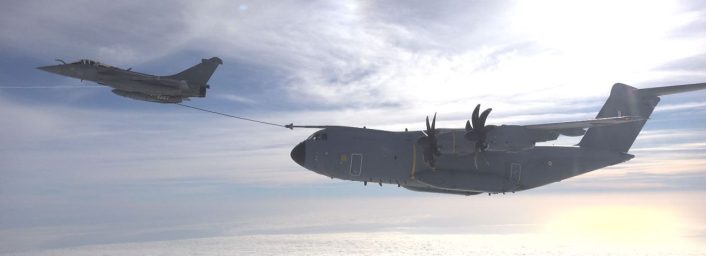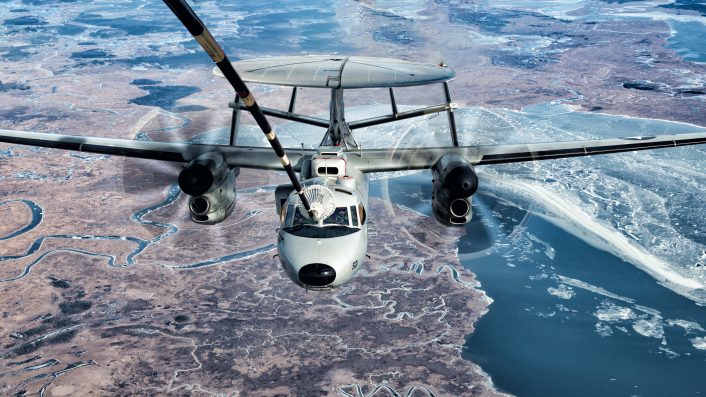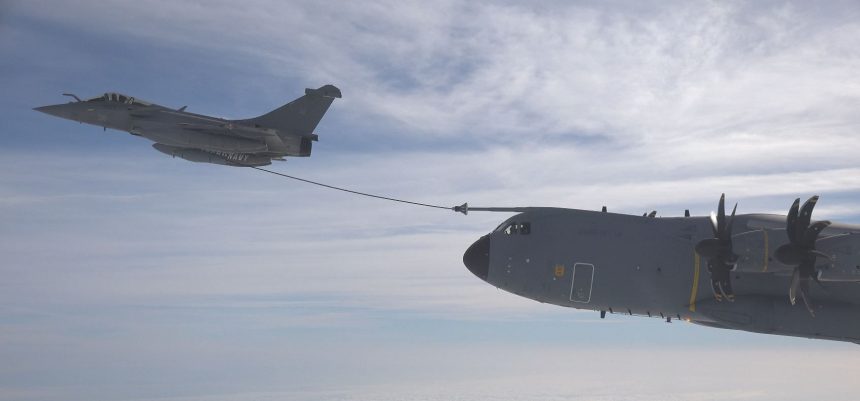The A400M acted as a surrogate for the E-2D Hawkeye, which the French Navy is acquiring, during the tests of the new NARANG air-to-air refueling pod for the Rafale M.
The French Directorate General of Armaments (DGA) shared on LinkedIn an interesting photo showing an unconventional buddy refueling operation, where the usual receiver and tanker have reversed their roles. In fact, a Rafale M is shown while refueling an A400M cargo during a test of the former’s new NARANG (nacelle de ravitaillement nouvelle generation, new generation refueling pod) buddy refueling pod.
The French Air and Space Force usually employs the A400M (together with the A330 MRTT) to refuel in flight its fighters on longer flights. During this test, however, the A400M acted as a surrogate receiver, simulating an E-2D Hawkeye AEW&C (Airborne Early Warning and Control) aircraft during the testing of NARANG, which will be employed by the French Navy’s Rafale while at sea to refuel other aircraft embarked on the Charles the Gaulle aircraft carrier.
The reason behind the test is the acquisition of the E-2D which, compared to the E-2C currently in service, introduces an air refueling capability. As mentioned by the DGA’s statement, this test will allow to verify the Rafale can safely operate the pod at a speed representative of the E-2D’s. If the result is positive, the Rafale will have the capability to refuel the Hawkeye for a safe landing on the carrier when the fuel reserves get too low at the end of a mission, a primary need when the aircraft are in the middle of the ocean.
To safely perform the refueling, the DGA notes the Rafale needs to reduce its speed appropriately to stabilize the basket at the end of the refueling hose. Once the receiver has made contact, the ram air turbine on the front end of the pod provides power to the pumps which will transfer the fuel.
The NARANG pod
The Rafale F3-R, which entered service in March 2021, introduced a new air refueling capability thanks to the NARANG pods. The pod was built by Safran on the basis of the lessons learned with the previous systems previously used by the now retired Etendard and Super Etendard and now the Rafale.
Safran further mentions that the previous pod allowed the Rafale to deliver fuel at a rate of 530 liters/minute, while the new generation system raises this to 750/ 1,000 liters/minute. The main advantage is, of course, the ability to decrease the time needed for refueling and the associated vulnerability when the two aircraft are flying only about ten meters from each other.
The French Navy certified the Narang in January 2021, just two months before the fielding of the Rafale F3-R. Since its first operational deployment during the Clemenceau mission performed by the Charles de Gaulle aircraft carrier in the same year, the pod has logged about 250 hours of operation.
The project, which was launched in 2011, foresaw the modernization of eight existing pods and the manufacturing of 16 new ones. Safran says the pod has also been acquired by unspecified export customers.

The French E-2D acquisition
France has been operating three E-2C Hawkeye aircraft since the early 2000s as the only foreign operator of the type on an aircraft carrier, beside the U.S. Navy. In 2020, the French Ministry of Armed Forces announced the approval of the acquisition of three new E-2Ds as replacement, with a Foreign Military Sales (FMS) agreement with the U.S. government approved in July that year.
The three E-2Ds are scheduled to be delivered by 2028, making France the second international operator of the type, said NAVAIR shortly after the signing of the Letter of Offer and Acceptance in December 2020. The acquisition follows, in fact, the procurement by Japan of 13 Hawkeyes, later increased to 18.
The E-2D Advanced Hawkeye (AHE) represents the latest evolution in the E-2 series, which has been the backbone of U.S. Navy’s airborne early warning and battle management capabilities for decades. This next-generation model brings a suite of advanced upgrades, making it far more capable and versatile than its predecessors, with improvements designed to ensure it meets the needs of modern warfare.
At the core of the E-2D is a state-of-the-art radar that offers what the U.S. Navy describes as a “two-generation leap” in capability over previous models. This advanced radar system dramatically increases detection range, target resolution, and tracking accuracy. The radar improvements, combined with other system upgrades, allow the E-2D to cover vast areas both at sea and over land, enhancing situational awareness for the fleet.

Unlike earlier models, the E-2D goes beyond simply relaying information, functioning as a highly integrated command and control node in a “digital quarterback” role. This makes it essential in managing diverse, concurrent missions, whether directing airborne strike operations, coordinating with ground forces, supporting search and rescue efforts, or serving as a communications hub across a dispersed fleet.
As mentioned earlier, the French aircraft will have an air refueling capability similar to the U.S. Navy’s aircraft. Another variation will be the integration of a computer, developed by the French Aerospace Industry Service (SIAé), which will guarantee an autonomous upgrade capability as per French requirements.









